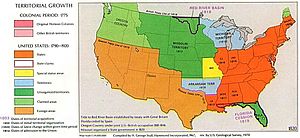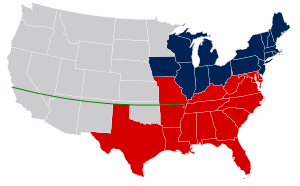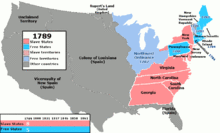- Missouri Compromise
-
 The United States in 1819. The Missouri Compromise prohibited slavery in the unorganized territory of the Great Plains (dark green) and permitted it in Missouri (yellow) and the Arkansas Territory (lower blue area).
The United States in 1819. The Missouri Compromise prohibited slavery in the unorganized territory of the Great Plains (dark green) and permitted it in Missouri (yellow) and the Arkansas Territory (lower blue area).
 Extension of the Missouri Compromise Line was part of the Texas Annexation Resolution of 1845 and further extension to the Pacific was considered before the Compromise of 1850 and in the proposed Crittenden Compromise of 1860.
Extension of the Missouri Compromise Line was part of the Texas Annexation Resolution of 1845 and further extension to the Pacific was considered before the Compromise of 1850 and in the proposed Crittenden Compromise of 1860.
Events leading to
the U.S. Civil War- Northwest Ordinance
- Kentucky and Virginia Resolutions
- Missouri Compromise
- Tariff of 1828
- Nullification Crisis
- Nat Turner's slave rebellion
- The Amistad
- Texas Annexation
- Mexican–American War
- Wilmot Proviso
- Ostend Manifesto
- Manifest Destiny
- Underground Railroad
- Fugitive Slave Act of 1850
- Compromise of 1850
- Uncle Tom's Cabin
- Kansas–Nebraska Act
- Bleeding Kansas
- Bleeding Sumner
- Dred Scott v. Sandford
- Brown's raid on Harper's Ferry
- 1860 presidential election
- Secession of Southern States
- Star of the West
- Corwin Amendment
- Battle of Fort Sumter
The Missouri Compromise was an agreement passed in 1820 between the pro-slavery and anti-slavery factions in the United States Congress, involving primarily the regulation of slavery in the western territories. It prohibited slavery in the former Louisiana Territory north of the parallel 36°30' north except within the boundaries of the proposed state of Missouri. Prior to the agreement, the House of Representatives had refused to accept this compromise and a conference committee was appointed.
A bill to enable the people of the Missouri Territory to draft a constitution and form a government preliminary to admission into the Union came before the House of Representatives in Committee of the Whole, on February 13, 1819. An amendment offered by James Tallmadge of New York (which was named the Tallmadge Amendment), which provided that the further introduction of slaves into Missouri should be forbidden, and that all children of slave parents born in the state after its admission should be free at the age of 25, was adopted by the committee and incorporated in the bill as finally passed on February 17, 1819 by the house. The United States Senate refused to concur in the amendment, and the whole measure was lost.
During the following session (1819–1820), the House passed a similar bill with an amendment, introduced on January 26, 1820 by John W. Taylor of New York, allowing Missouri into the union as a slave state. The question had been complicated by the admission in December of Alabama, a slave state, making the number of slave and free states equal. In addition, there was a bill in passage through the House (January 3, 1820) to admit Maine as a free state.
The Senate decided to connect the two measures. It passed a bill for the admission of Maine with an amendment enabling the people of Missouri to form a state constitution. Before the bill was returned to the House, a second amendment was adopted on the motion of Jesse B. Thomas of Illinois, excluding slavery from the Missouri Territory north of the parallel 36°30' north (the southern boundary of Missouri), except within the limits of the proposed state of Missouri.
Contents
Impact on political discourse
These disputes involved the competition between the southern and northern states for power in Congress and for control over future territories. There were also different factions emerging as the Democratic-Republican party began to lose its coherence.
In an April 21 letter to John Holmes, Thomas Jefferson wrote that the division of the country created by the Compromise Line would eventually lead to the destruction of the Union:
...but this momentous question, like a fire bell in the night, awakened and filled me with terror. I considered it at once as the knell of the Union. it is hushed indeed for the moment. but this is a reprieve only, not a final sentence. a geographical line, coinciding with a marked principle, moral and political, once conceived and held up to the angry passions of men, will never be obliterated; and every new irritation will mark it deeper and deeper.[1]
Congress's consideration of Missouri's admission also raised the issue of sectional balance, for the country was equally divided between slave and free states, with eleven each. To admit Missouri as a slave state would tip the balance in the Senate (made up of two senators per state) in favor of the slave states. For this reason, northern states wanted Maine to be admitted as a free state. The people of Dedham, Massachusetts were against the compromise and sent a petition to Senator Edward Everett addressing their grievance. Everett presented the petition on the floor of the Senate on April 6, 1854.[2]
On the constitutional side, the Compromise of 1820 was important as the first instance of Congressional exclusion of slavery from public territory acquired since the Northwest Ordinance.
Following Maine 1820 [3] and Missouri's 1821 [4] admissions to the Union, no other states were admitted until 1836. Arkansas was admitted [5] as a slave state, followed by Michigan in 1837 [6] as a free state.
Second Missouri Compromise
The two houses were at odds not only on the issue of slavery, but also on the parliamentary question of the inclusion of Maine and Missouri within the same bill. The committee recommended the enactment of two laws, one for the admission of Maine, the other an enabling act for Missouri. They recommended against having restrictions on slavery but for including the Thomas amendment. Both houses agreed, and the measures were passed on March 5, 1820, and ratified by President James Monroe on March 6.
The question of the final admission of Missouri came up during the session of 1820–1821. The struggle was revived over a clause in its new constitution (1820) requiring the exclusion of "free negroes and mulattoes" from the state. Through the influence of Henry Clay, an act of admission was finally passed, upon the condition that the exclusionary clause of the Missouri constitution should "never be construed to authorize the passage of any law" impairing the privileges and immunities of any U.S. citizen. This deliberately ambiguous provision is sometimes known as the Second Missouri Compromise.
Repeal
The provisions of the Missouri Compromise forbidding slavery in the former Louisiana Territory north of the parallel 36°30' north were effectively repealed by the Kansas-Nebraska Act of 1854, despite efforts made to fight the Act by prominent speakers, including Abraham Lincoln[7] in his "Peoria Speech."
In the Dred Scott v. Sandford case in 1857, the Supreme Court ruled that Congress did not have authority to prohibit slavery in territories, and that those provisions of the Missouri Compromise were unconstitutional. It found that, under the admission act of Missouri, blacks and mulattos did not qualify as citizens of the United States.
See also
- Compromise of 1790
- Compromise of 1850
- Origins of the American Civil War
- Royal Colonial Boundary of 1665
- Tallmadge Amendment
Notes
- ^ Thomas Jefferson to John Holmes. April 22, 1820.
- ^ "Thirty-Third Congress". The New York Times. April 7, 1854.
- ^ Library of Congress – Maine Becomes a State. March 15, 1820.
- ^ Library of Congress – Missouri Becomes a State. August 10, 1821.
- ^ Library of Congress – Arkansas Becomes a State. June 15, 1836.
- ^ Library of Congress – Arkansas Becomes a State. January 26, 1837.
- ^ Lincoln at Peoria
References
- Forbes, Robert. The Missouri Compromise and Its Aftermath: Slavery and the Meaning of America (2007), the major scholarly treatise
- Howe, Daniel Walker. "Missouri, Slave Or Free?" American Heritage, Summer 2010, Vol. 60 Issue 2, p21-23 [online]
- Wilentz, Sean. "Jeffersonian Democracy and the Origins of Political Antislavery in the United States: The Missouri Crisis Revisited," Journal of the Historical Society, Sept 2004, Vol. 4 Issue 3, pp 375-401
 "Missouri Compromise". New International Encyclopedia. 1905.
"Missouri Compromise". New International Encyclopedia. 1905.
External links
American Civil War (outline) Origins - Combatants
- Theaters
- Campaigns
- Battles
- States
CombatantsTheatersMajor battles- Fort Sumter
- 1st Bull Run
- Wilson's Creek
- Fort Donelson
- Pea Ridge
- Hampton Roads
- Shiloh
- New Orleans
- Corinth
- Seven Pines
- Seven Days
- 2nd Bull Run
- Antietam
- Perryville
- Fredericksburg
- Stones River
- Chancellorsville
- Gettysburg
- Vicksburg
- Chickamauga
- Chattanooga
- Wilderness
- Spotsylvania
- Cold Harbor
- Atlanta
- Mobile Bay
- Franklin
- Nashville
- Five Forks
Involvement
by state or territoryLeaders ConfederateMilitaryCivilianUnionMilitaryCivilianAftermath - Alabama Claims
- Carpetbaggers
- Freedman's Bank
- Freedmen's Bureau
- Jim Crow laws
- Redeemers
- Southern Claims Commission
Cemeteries- Confederate memorials and cemeteries
- National cemeteries
- U.S. memorials and cemeteries
VeternsOther topics- Related topics
- Categories
Related topicsMilitaryPoliticalOther topicsCategories- American Civil War
- People
- Battles
- Union Army generals
- Union armies
- Union Army corps
- Confederate States of America (CSA)
- Confederate Army generals
- Confederate armies
- Spies
- National Battlefields
- Veterans' organizations
- Medicine
- Museums
- Forts
- Old soldiers' homes
- Prisons
- Reconstruction
- U.S. memorials and cemeteries
- Confederate memorials and cemeteries
American Civil War at sister projects  American Civil War portal
American Civil War portal Military History: American Civil War
Military History: American Civil War Special Project: Brothers at War
Special Project: Brothers at War
Categories:- Missouri in the American Civil War
- 16th United States Congress
- 1820 in American politics
- 1820 in law
- African American history
- History of United States expansionism
- Legal history of Missouri
- Presidency of James Monroe
- Slavery in the United States
- United States federal territory and statehood legislation
Wikimedia Foundation. 2010.

